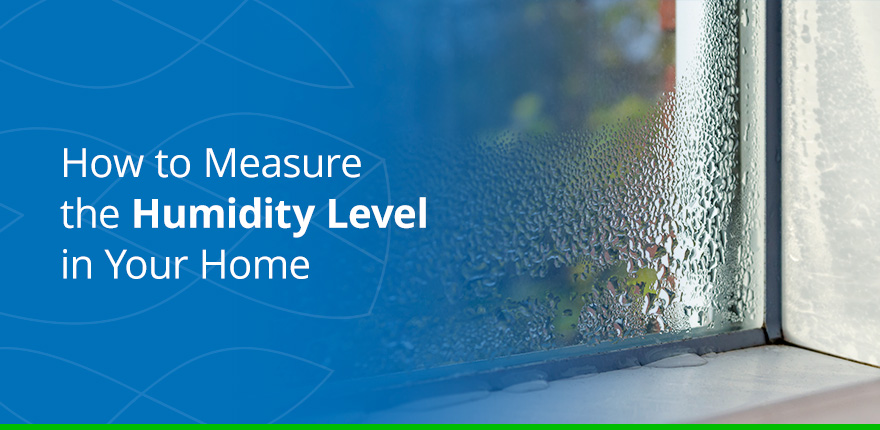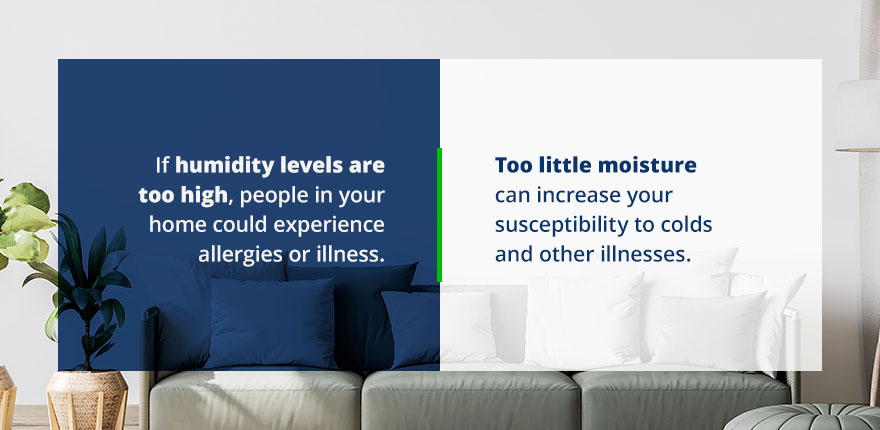

Humidity levels can be an issue whether they’re too high or too low. Homeowners should pay attention to humidity levels — ignoring them can lead to home damage and health issues. If you suspect high or low humidity throughout your house, you’ll need to take steps to balance it. Thankfully, it’s easy to adjust humidity levels with simple changes. Learn how to test the humidity level in your home and achieve the best home humidity level.
If you’re wondering how to check humidity levels in your home, the most reliable method is to use a hygrometer. It measures the amount of water vapor in the air. The number it displays is the relative humidity, which is the percentage of vapor in the air compared to the highest possible amount.
You can also use a less scientific method to determine humidity. All you have to do is pour yourself a glass of water and drop a few ice cubes in it. Leave it in an unoccupied room for a few minutes. Be sure to place it away from the kitchen, where cooking can lead to skewed results. When you come back to it, it should have a bit of condensation on the outside. If the outside of the glass is dry, your humidity levels might be too low. If the glass is sweating excessively, your humidity could be too high.
The ideal humidity level should fall somewhere between 30% and 50%. This means the air is holding 30% to 50% of the maximum amount of moisture it could contain. If your home’s humidity level is extremely high or low, you’ll likely be able to tell. Both will affect your home and health in adverse ways.
You need to know how to test the humidity in your home because it’s more important than you might realize. Both too much and too little humidity can damage your home and threaten your health. Humidity levels should be balanced, not too high or too low. Here are some of the consequences related to imbalanced humidity.

Too much humidity in your home can damage your house and furniture. The buildup of moisture can weigh on your walls and ceilings and cause paint to crack and blister.
Another concern is your family’s health — microbial life thrives in humid conditions. In other words, your house could become a breeding ground for mold, mildew, dust mites, bacteria, and viruses. If your humidity levels are too high, people living in your home could experience allergies or illness.
Microbial buildup can also result from dirty air ducts. You may need to have your heating, ventilation, and air conditioning (HVAC) vents cleaned to limit harmful contaminants. Clean vents will help your HVAC system run smoothly, increasing its efficiency and reducing your heating and cooling costs.
Low humidity levels are a concern, as well, for different reasons. Lacking humidity can lead to extra dust buildup throughout your home. It can also cause your wooden floors or furniture to crack and ruin electrical equipment.
You’ll feel the effects of low humidity. It causes dry skin and hair, as well as chapped lips. Too little moisture can increase your susceptibility to colds and other illnesses. Your immune system is less capable of defending and repairing your body when not enough moisture is present, which is one of the reasons flu viruses thrive during dry winter months. In addition, the extra dust buildup can increase allergic reactions.
You should test your home’s humidity levels if you notice signs of too little or too much humidity. Look for the following side effects of too much humidity in your home:
You should also look for signs of too little humidity, which include the following:
If your house’s humidity is too high or too low, you can take steps to balance it. A few simple measures can make your home safe and comfortable. Here are some of the ways you can manage your home’s humidity.
When humidity levels are too low, an easy fix is to purchase a humidifier. You might want to purchase more than one and distribute them throughout your home. A more economical way to increase your home’s humidity is to place shallow dishes of water throughout your home. The best placement is near a heat source, such as a radiator, vent, or well-lit window. The heat will encourage the water to evaporate into your house.
High humidity is sometimes due to poor ventilation near indoor water sources, like washing machines or showers. If water is accumulating in your kitchen, bathroom, or laundry area, try methods to improve ventilation. Open windows and doors to increase circulation. Use an exhaust fan or dehumidifier near your water-producing appliances.
Whether humidity is too high or too low, you may need to service or upgrade your home’s HVAC system. Regular maintenance can help ensure your system is running properly. A new unit might improve your indoor air quality and your home’s energy efficiency. You may also benefit from indoor air quality technology, such as humidity control products and air purifying systems.
Humidity levels, though often overlooked, are vital for your home and your safety. Too little moisture in the air can cause uncomfortable and unfavorable side effects, such as dry skin, weakened immune systems, and cracked furniture. On the other hand, too much moisture in the air might encourage microbial growth, increasing the number of allergens, bacteria, and viruses in your home. It can also lead to damaging water buildup.
If you’re looking for a reliable and professional home humidity testing service, the experts at Shipley Energy can help. We’ll determine if your humidity levels are too high or low and find the source of the issue. We’ll then work with you to decide on the best solution for your home and family. Here at Shipley Energy, our knowledgeable professionals help homeowners make informed decisions. We’re a reputable home energy supplier with almost a century of experience. Contact us at Shipley Energy to learn about home humidity testing and other residential services.
